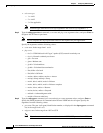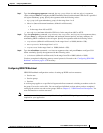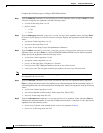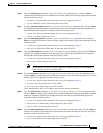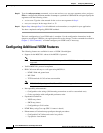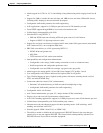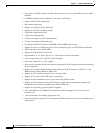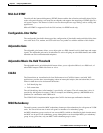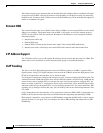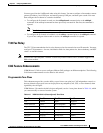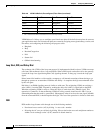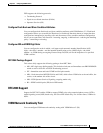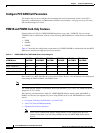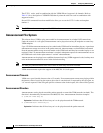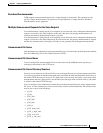
4-56
Cisco VISM Installation and Configuration Guide
Release 3.0, Part Number OL-2521-01 Rev. D0, June 2004
Chapter 4 Configuring VISM Features
Configuring Additional VISM Features
This feature requires you to add more than one domain name and configure these as redundant call agents
or the same logical MGC. Only the IP addresses corresponding to each physical entity are returned by
the DNS server. In order to allow VISMs to traverse all the IP addresses, you must identify these physical
entities as redundant call agents.
External DNS
The external domain name server (DNS) feature allows VISM to use an external DNS to resolve the IP
address you configure. The domain names can be MGCs, call agents, or trivial file transfer protocol
(TFTP) servers used for CAS file downloads. Resolution of IP addresses can be configured with the
following methods:
• Internal static tables only
• External DNS only
• External DNS, followed by the internal static tables if the external DNS method fails
• Internal static tables, followed by the external DNS if the internal static table method fails
2 IP Address Support
The 2 IP address allows you to add separate IP addresses for the control and data paths for VISM. This
feature removes the restriction of control and data traffic going to two different domains.
VoIP Trunking
The Voice over IP (VoIP) trunking feature allows the VISM to connect to the PBX, or central office
digital systems, using T1/E1 digital interfaces and converts the TDM bit stream into RTP packets, after
ECAN and compression, and transports it over the IP network.
No call agent is required for setting up and tearing down calls. You must configure the DS0 circuits. The
connection between VISM and the first router will be ATM after which it will be IP only. VISM and the
router can have one or multiple PVCs to transport the data. You have the option to configure PVC for
bearer or control. If the PVC is configured as bearer and no control PVC exists, then PRI signal traffic
and bearer traffic will go through this PVC. If you configure separate PVCs for control and bearer, PRI
signaling will go through control traffic only. You can modify some of the connection parameters after
it is added.
CAS is transported to the far end using a Cisco proprietary format (not NSEs). PRI is transported over
RUDP to the far end once the trunk is provisioned between the originating and terminating VISM.
PRI transport is handled in a way identical to PRI backhaul except that the PRI traffic is sent to remote
gateway instead of a call agent. You can configure one line for PRI trunking and another line for PRI
backhauling.



